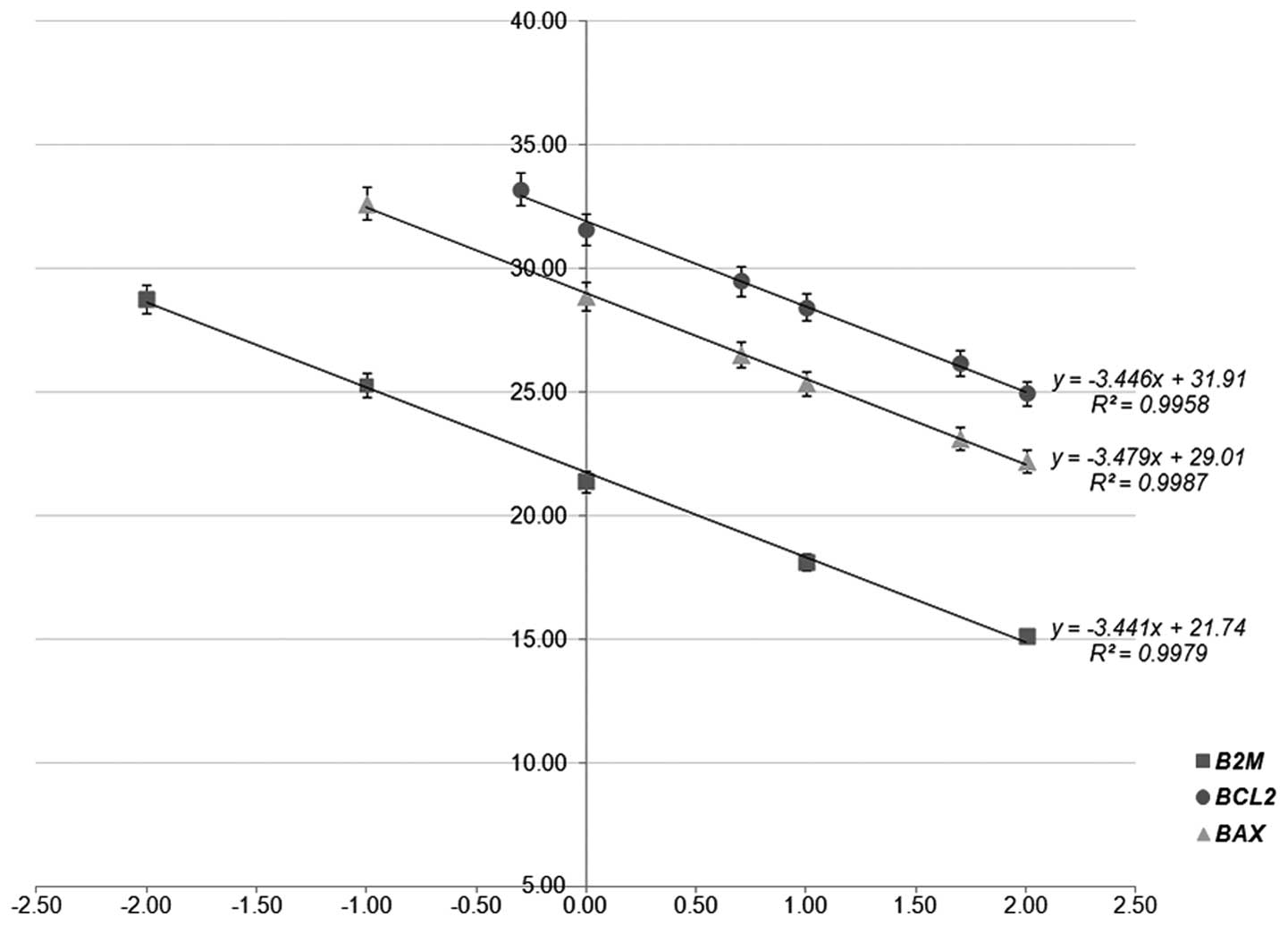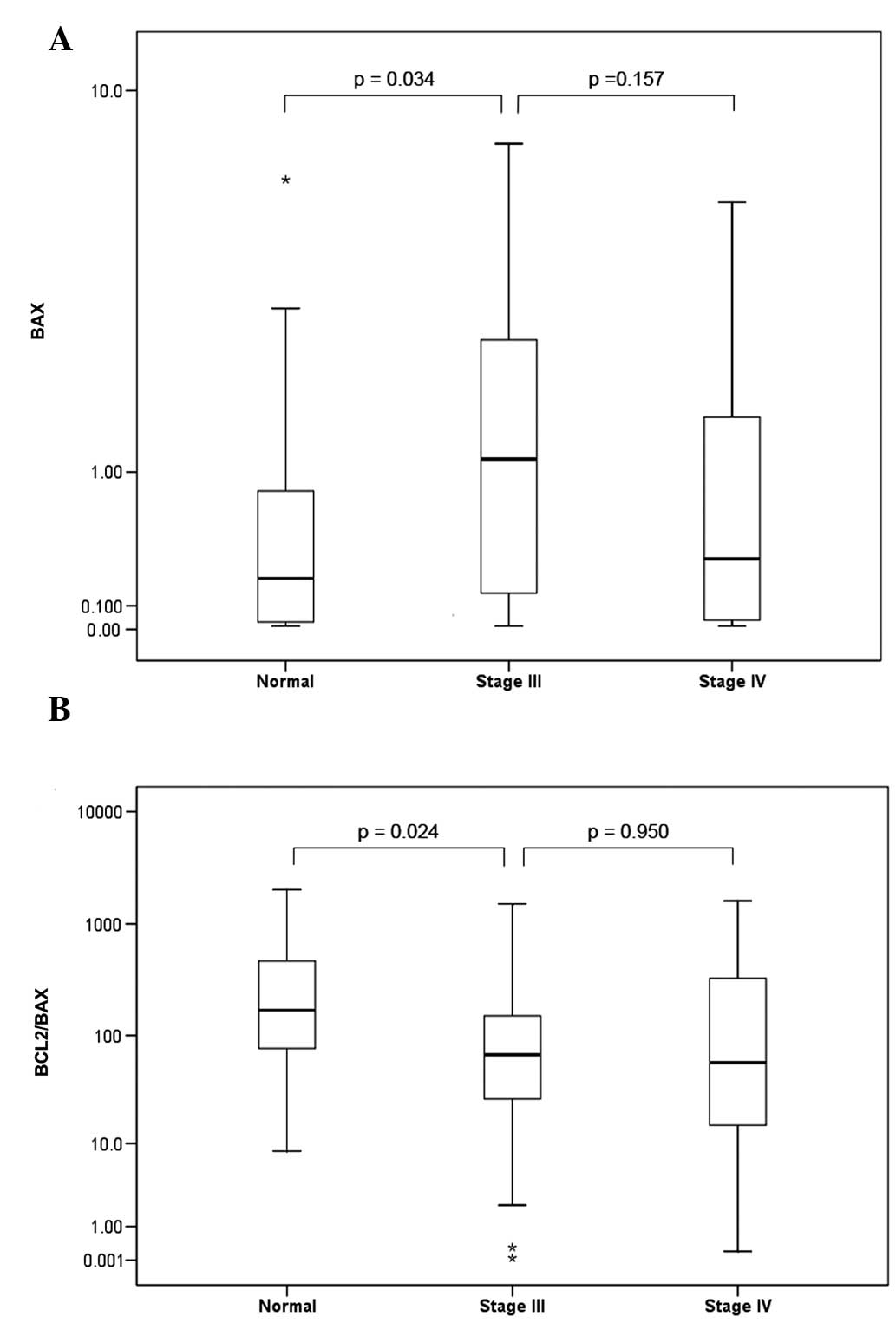|
1
|
Chang J, Wang W, Zhang H, Hu Y, Wang M and
Yin Z: The dual role of autophagy in chondrocyte responses in the
pathogenesis of articular cartilage degeneration in osteoarthritis.
Int J Mol Med. 32:1311–1318. 2013.PubMed/NCBI
|
|
2
|
Mutijima E, De Maertelaer V, Deprez M,
Malaise M and Hauzeur JP: The apoptosis of osteoblasts and
osteocytes in femoral head osteonecrosis: its specificity and its
distribution. Clin Rheumatol. 33:1791–1795. 2014. View Article : Google Scholar : PubMed/NCBI
|
|
3
|
Vaillancourt F, Fahmi H, Shi Q, et al:
4-Hydroxynonenal induces apoptosis in human osteoarthritic
chondrocytes: the protective role of glutathione-S-transferase.
Arthritis Res Ther. 10:R1072008. View
Article : Google Scholar : PubMed/NCBI
|
|
4
|
Grogan SP and D'Lima DD: Joint aging and
chondrocyte cell death. Int J Clin Rheumtol. 5:199–214. 2010.
View Article : Google Scholar : PubMed/NCBI
|
|
5
|
Blagojevic M, Jinks C, Jeffery A and
Jordan KP: Risk factors for onset of osteoarthritis of the knee in
older adults: a systematic review and meta-analysis. Osteoarthritis
Cartilage. 18:24–33. 2010. View Article : Google Scholar
|
|
6
|
Felson DT, Lawrence RC, Dieppe PA, et al:
Osteoarthritis: new insights. Part 1: the disease and its risk
factors. Ann Intern Med. 133:635–646. 2000. View Article : Google Scholar : PubMed/NCBI
|
|
7
|
Thomadaki H and Scorilas A: BCL2 family of
apoptosis-related genes: functions and clinical implications in
cancer. Crit Rev Clin Lab Sci. 43:1–67. 2006. View Article : Google Scholar : PubMed/NCBI
|
|
8
|
Johnson EO, Charchandi A, Babis GC and
Soucacos PN: Apoptosis in osteoarthritis: morphology, mechanisms,
and potential means for therapeutic intervention. J Surg Orthop
Adv. 17:147–152. 2008.PubMed/NCBI
|
|
9
|
Korsmeyer SJ, Shutter JR, Veis DJ, Merry
DE and Oltvai ZN: Bcl-2/BAX: a rheostat that regulates an
anti-oxidant pathway and cell death. Semin Cancer Biol. 4:327–332.
1993.PubMed/NCBI
|
|
10
|
Reed JC: Double identity for proteins of
the Bcl-2 family. Nature. 387:773–776. 1997. View Article : Google Scholar : PubMed/NCBI
|
|
11
|
Cory S and Adams JM: The BCL2 family:
regulators of the cellular life-or-death switch. Nat Rev Cancer.
2:647–656. 2002. View
Article : Google Scholar : PubMed/NCBI
|
|
12
|
Hockenbery D, Nuñez G, Milliman C,
Schreiber RD and Korsmeyer SJ: Bcl-2 is an inner mitochondrial
membrane protein that blocks programmed cell death. Nature.
348:334–336. 1990. View Article : Google Scholar : PubMed/NCBI
|
|
13
|
Oltvai ZN and Korsmeyer SJ: Checkpoints of
dueling dimers foil death wishes. Cell. 79:189–192. 1994.
View Article : Google Scholar : PubMed/NCBI
|
|
14
|
Iannone F and Lapadula G: The
pathophysiology of osteoarthritis. Aging Clin Exp Res. 15:364–372.
2003. View Article : Google Scholar
|
|
15
|
Martel-Pelletier J, Boileau C, Pelletier
JP and Roughley PJ: Cartilage in normal and osteoarthritis
conditions. Best Pract Res Clin Rheumatol. 22:351–384. 2008.
View Article : Google Scholar : PubMed/NCBI
|
|
16
|
Kim HA, Lee YJ, Seong SC, Choe KW and Song
YW: Apoptotic chondrocyte death in human osteoarthritis. J
Rheumatol. 27:455–462. 2000.PubMed/NCBI
|
|
17
|
Aigner T, Hemmel M, Neureiter D, et al:
Apoptotic cell death is not a widespread phenomenon in normal aging
and osteoarthritis human articular knee cartilage: a study of
proliferation, programmed cell death (apoptosis), and viability of
chondrocytes in normal and osteoarthritic human knee cartilage.
Arthritis Rheum. 44:1304–1312. 2001. View Article : Google Scholar : PubMed/NCBI
|
|
18
|
Cheng AX, Lou SQ, Zhou HW, Wang Y and Ma
DL: Expression of PDCD5, a novel apoptosis related protein, in
human osteoarthritic cartilage. Acta Pharmacol Sin. 25:685–690.
2004.PubMed/NCBI
|
|
19
|
Héraud F, Héraud A and Harmand MF:
Apoptosis in normal and osteoarthritic human articular cartilage.
Ann Rheum Dis. 59:959–965. 2000. View Article : Google Scholar : PubMed/NCBI
|
|
20
|
Horton WE Jr, Feng L and Adams C:
Chondrocyte apoptosis in development, aging and disease. Matrix
Biol. 17:107–115. 1998. View Article : Google Scholar : PubMed/NCBI
|
|
21
|
Lu H, Hou G, Zhang Y, Dai Y and Zhao H:
c-Jun transactivates Puma gene expression to promote
osteoarthritis. Mol Med Rep. 9:1606–1612. 2014.PubMed/NCBI
|
|
22
|
Zamli Z, Adams MA, Tarlton JF and Sharif
M: Increased chondrocyte apoptosis is associated with progression
of osteoarthritis in spontaneous Guinea pig models of the disease.
Int J Mol Sci. 14:17729–17743. 2013. View Article : Google Scholar : PubMed/NCBI
|
|
23
|
Thomas CM, Fuller CJ, Whittles CE and
Sharif M: Chondrocyte death by apoptosis is associated with the
initiation and severity of articular cartilage degradation. Int J
Rheum Dis. 14:191–198. 2011. View Article : Google Scholar : PubMed/NCBI
|
|
24
|
Blanco FJ, Guitian R, Vázquez-Martul E, de
Toro FJ and Galdo F: Osteoarthritis chondrocytes die by apoptosis.
A possible pathway for osteoarthritis pathology. Arthritis Rheum.
41:284–289. 1998. View Article : Google Scholar : PubMed/NCBI
|
|
25
|
Hu J, Huang G, Huang S and Yang L: Control
genes of chondrocyte apoptosis in osteoarthritic articular
cartilage. Zhonghua Wai Ke Za Zhi. 38:266–268. 2172000.
|
|
26
|
Wang SJ, Guo X, Chen JH, et al: Mechanism
of chondrocyte apoptosis in Kashin-Beck disease and primary
osteoarthritis: a comparative study. Nan Fang Yi Ke Da Xue Xue Bao.
26:927–930. 2006.PubMed/NCBI
|
|
27
|
Kellgren JH and Lawrence JS: Radiological
assessment of osteoarthrosis. Ann Rheum Dis. 16:494–502. 1957.
View Article : Google Scholar : PubMed/NCBI
|
|
28
|
Pombo-Suarez M, Calaza M, Gomez-Reino JJ
and Gonzalez A: Reference genes for normalization of gene
expression studies in human osteoarthritic articular cartilage. BMC
Mol Biol. 9:172008. View Article : Google Scholar : PubMed/NCBI
|
|
29
|
Schmittgen TD and Livak KJ: Analyzing
real-time PCR data by the comparative C(T) method. Nat Protoc.
3:1101–1108. 2008. View Article : Google Scholar : PubMed/NCBI
|
|
30
|
Hanley JA and McNeil BJ: The meaning and
use of the area under a receiver operating characteristic (ROC)
curve. Radiology. 143:29–36. 1982. View Article : Google Scholar : PubMed/NCBI
|
|
31
|
Hashimoto S, Ochs RL, Komiya S and Lotz M:
Linkage of chondrocyte apoptosis and cartilage degradation in human
osteoarthritis. Arthritis Rheum. 41:1632–1638. 1998. View Article : Google Scholar : PubMed/NCBI
|
|
32
|
Kourí JB, Aguilera JM, Reyes J, Lozoya KA
and González S: Apoptotic chondrocytes from osteoarthrotic human
articular cartilage and abnormal calcification of subchondral bone.
J Rheumatol. 27:1005–1019. 2000.PubMed/NCBI
|
|
33
|
Yatsugi N, Tsukazaki T, Osaki M, Koji T,
Yamashita S and Shindo H: Apoptosis of articular chondrocytes in
rheumatoid arthritis and osteoarthritis: correlation of apoptosis
with degree of cartilage destruction and expression of
apoptosis-related proteins of p53 and c-myc. J Orthop Sci.
5:150–156. 2000. View Article : Google Scholar : PubMed/NCBI
|
|
34
|
Sharif M, Whitehouse A, Sharman P, Perry M
and Adams M: Increased apoptosis in human osteoarthritic cartilage
corresponds to reduced cell density and expression of caspase-3.
Arthritis Rheum. 50:507–515. 2004. View Article : Google Scholar : PubMed/NCBI
|
|
35
|
Tallman MS, Gilliland DG and Rowe JM: Drug
therapy for acute myeloid leukemia. Blood. 106:1154–1163. 2005.
View Article : Google Scholar : PubMed/NCBI
|
|
36
|
Köhler T, Schill C, Deininger MW, et al:
High Bad and BAX mRNA expression correlate with negative outcome in
acute myeloid leukemia (AMl). Leukemia. 16:22–29. 2002. View Article : Google Scholar : PubMed/NCBI
|
|
37
|
Chen JH, Cao JL, Chu YL, Wang ZL, Yang ZT
and Wang HL: T-2 toxin-induced apoptosis involving Fas, p53,
Bcl-xL, Bcl-2, BAX and caspase-3 signaling pathways in human
chondrocytes. J Zhejiang Univ Sci B. 9:455–463. 2008. View Article : Google Scholar : PubMed/NCBI
|
|
38
|
Horton WE Jr, Yagi R, Laverty D and Weiner
S: Overview of studies comparing human normal cartilage with
minimal and advanced osteoarthritic cartilage. Clin Exp Rheumatol.
23:103–112. 2005.PubMed/NCBI
|
|
39
|
Lee EK, Jung KJ, Choi J, et al: Molecular
basis for age-related changes in ileum: involvement of
BAX/caspase-dependent mitochondrial apoptotic signaling. Exp
Gerontol. 45:970–976. 2010. View Article : Google Scholar : PubMed/NCBI
|
|
40
|
Phaneuf S and Leeuwenburgh C: Cytochrome c
release from mitochondria in the aging heart: a possible mechanism
for apoptosis with age. Am J Physiol Regul Integr Comp Physiol.
282:R423–R430. 2002. View Article : Google Scholar : PubMed/NCBI
|
|
41
|
Gupta S: Molecular and biochemical
pathways of apoptosis in lymphocytes from aged humans. Vaccine.
18:1596–1601. 2000. View Article : Google Scholar : PubMed/NCBI
|
|
42
|
Das P, Chopra M, Sun Y, Kerns DG,
Vastardis S and Sharma AC: Age-dependent differential expression of
apoptosis markers in the gingival tissue. Arch Oral Biol.
54:329–336. 2009. View Article : Google Scholar : PubMed/NCBI
|
|
43
|
Aggarwal S and Gupta S: Increased
apoptosis of T cell subsets in aging humans: altered expression of
Fas (CD95), Fas ligand, Bcl-2, and BAX. J Immunol. 160:1627–1637.
1998.PubMed/NCBI
|
|
44
|
Mistry D, Oue Y, Chambers MG, Kayser MV
and Mason RM: Chondrocyte death during murine osteoarthritis.
Osteoarthritis Cartilage. 12:131–141. 2004. View Article : Google Scholar : PubMed/NCBI
|
|
45
|
Temple MM, Bae WC, Chen MQ, et al: Age-
and site-associated biomechanical weakening of human articular
cartilage of the femoral condyle. Osteoarthritis Cartilage.
15:1042–1052. 2007. View Article : Google Scholar : PubMed/NCBI
|
|
46
|
Barbero A, Grogan S, Schäfer D, Heberer M,
Mainil-Varlet P and Martin I: Age related changes in human
articular chondrocyte yield, proliferation and post-expansion
chondrogenic capacity. Osteoarthritis Cartilage. 12:476–484. 2004.
View Article : Google Scholar : PubMed/NCBI
|
|
47
|
Yang C, Li SW, Helminen HJ, Khillan JS,
Bao Y and Prockop DJ: Apoptosis of chondrocytes in transgenic mice
lacking collagen II. Exp Cell Res. 235:370–373. 1997. View Article : Google Scholar : PubMed/NCBI
|
|
48
|
Feng L, Precht P, Balakir R and Horton WE
Jr: Evidence of a direct role for Bcl-2 in the regulation of
articular chondrocyte apoptosis under the conditions of serum
withdrawal and retinoic acid treatment. J Cell Biochem. 71:302–309.
1998. View Article : Google Scholar : PubMed/NCBI
|
|
49
|
Mukherjee P, Rachita C, Aisen PS and
Pasinetti GM: Non-steroidal anti-inflammatory drugs protect against
chondrocyte apoptotic death. Clin Exp Rheumatol. 19(Suppl 22):
S7–S11. 2001.PubMed/NCBI
|
|
50
|
Amling M, Neff L, Tanaka S, et al: Bcl-2
lies downstream of parathyroid hormone-related peptide in a
signaling pathway that regulates chondrocyte maturation during
skeletal development. J Cell Biol. 136:205–213. 1997. View Article : Google Scholar : PubMed/NCBI
|
|
51
|
Zamli Z and Sharif M: Chondrocyte
apoptosis: a cause or consequence of osteoarthritis? Int J Rheum
Dis. 14:159–166. 2011. View Article : Google Scholar : PubMed/NCBI
|

















